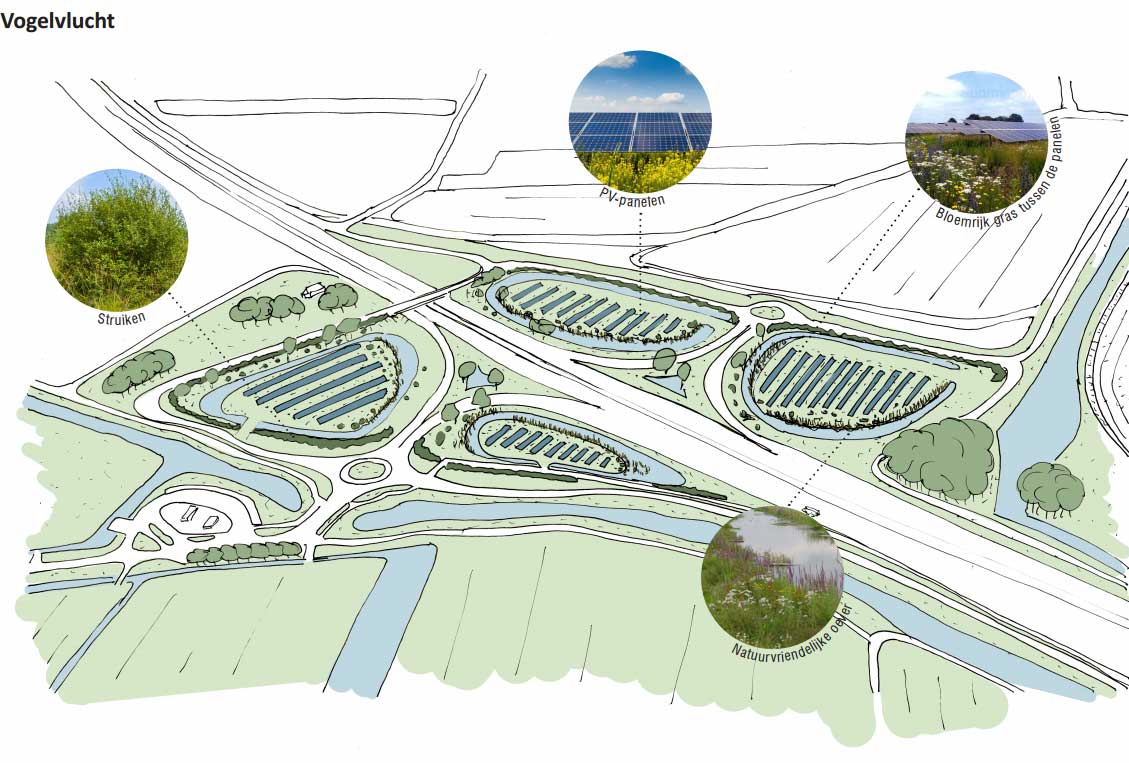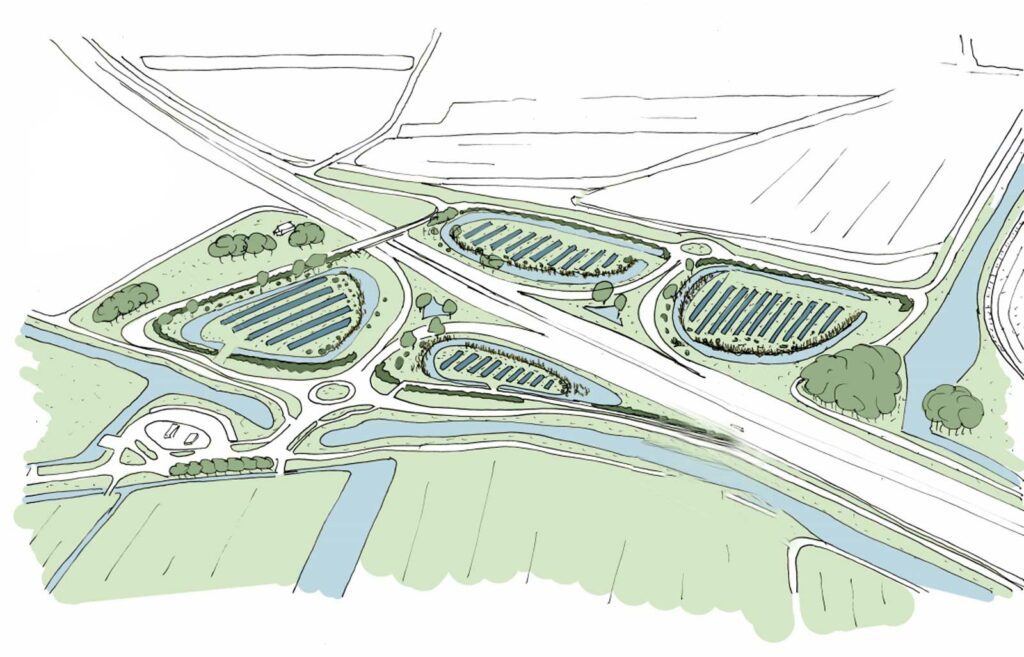News
Sun along the A7: approach and lessons learned
North Holland is exploring options for generating renewable energy along highways. One of the pilot projects is “Zon langs de A7. Francois Bonajo (Rijksvastgoedbedrijf) and René Houtwipper (Ecorus) talk about the approach to this project and share the lessons they have already learned.
Along the A7 freeway between Hoorn and Den Oever, four slip roads at Wognum, Abbekerk, Medemblik and Middenmeer are being fitted with solar fields. This is being done as part of “Zon langs de A7,” one of the first ten pilot projects of the OER program. The pilot project is part of the North Holland North Regional Energy Strategy (RES). Double use of space of slip roads and exits makes efficient use of scarce space.
Rijkswaterstaat is investigating whether more slip roads along the A7 can be fitted with solar fields in the future. “The pilot projects contribute to the energy transition. They are also intended to gain experience, to see what works and what doesn’t,” Francois Bonajo explained. He is project manager for renewable energy at the Government Property Agency. Some of the state-owned land can be offered to the market by the State Property Company.
Solar along the A7 is a promising initiative. A reconnaissance showed that at the four junctions a total of about 5.5 hectares is available for solar panels. That is good for about 5.5 MW of production capacity for green electricity.
Prior to the public tender, a market consultation was first held, Bonajo says. “The feasibility of the project seemed difficult: grid congestion, a relatively small area spread over four locations, two landowners and two municipalities involved. The market consultation gave a mixed picture.”
Nevertheless, several parties signed up, after which the project was awarded to Ecorus. This company has had experience in the development and realization of solar parks, including along highways, since 2016. “We were awarded the contract because our participation plan met the policy of the municipalities,” says René Houtwipper. As project manager of solar on land projects at Ecorus, he is responsible for the Zon langs de A7 project.
The preparation of Zon langs de A7 has started, but those who expect the solar panels to be installed as early as this year must be patient. “Developers are given two years by us to elaborate their plans. That is stipulated in the preliminary agreement. After that, the building rights will be established and realization can begin,” Bonajo says.
Woodwipper: “I think we will be very optimistic when we get to implementation in two years, but we are aiming for that. Preliminary work has already been done, but there is no permit and no grid connection yet. We have signed the preliminary agreement, but the planning and participation still have to happen. It takes time to do that carefully.”
Cooperation with other parties also takes time, Woodwipper adds. “We are not only cooperating with the Rijksvastgoedbedrijf, but also with Rijkswaterstaat, the province of North Holland, municipalities, the Hoogheemraadschap, but especially with people who live or work in the immediate vicinity. All those parties are involved in this project.” The project involves four locations, in two municipalities and with two landowners, Bonajo says. “That doesn’t make it any easier, neither for us nor for Ecorus.”
Solar along A7 at Abbekerk interchange. Sketch by VlugP Buro voor Stedenbouw en Landschapsarchitectuur from Amsterdam

For Zon along the A7, solar panels were chosen on the ground, along the roadside. That is the most common method, Bonajo says. “That is relatively simple. With solar panels on noise barriers, for example, the situation is more complex than if panels are placed on the ground, both in a technical and legal sense. That raises several questions, such as: is the noise barrier strong enough to support the panels, is it safe enough, how do we arrange it legally properly? That requires additional research and efforts to get that right.”
Woodwipper: “It is also possible to cover parking lots along the highway or even the highway itself with solar panels, but that is still experimental and innovative. If we were to do that, there has to be an elaborate plan that guarantees safety. That requires huge pre-investments. And then you always have to wait and see whether such a plan is accepted. For Zon along the A7, we are mainly putting solar panels on the ground, so no canopies.”
The most efficient approach is to place as many solar panels as possible in a field, says Woodwipper. “We want to make the best use of the space. In practice, however, we also have to consider other issues, such as making sure the solar panels are accessible for maintenance. We also have to make sure that the solar field can be connected to the grid in a smart way, through an existing connection, or else through a new connection. A new connection requires a cable to be pulled to a substation, preferably nearby. This determines not only the cost and payback time, but also the load on the power grid.”
“Even a relatively small project like Solar along the A7 has an impact on the grid balance. To reduce grid congestion, Ecorus is looking for an existing grid connection, Woodwipper explains. “We sought cooperation with FastNed, which has charging stations at two of the four locations. Those charging stations already have a connection, but also a need for electricity. We are going to explore together what is possible. We are also looking at a wind farm and a business park, which can help us with an existing grid connection.”
Woodwipper: “Landscape integration is always the starting point, with every solar farm. This is important to create support in the area. Almost everyone is in favor of the energy transition, but when there is talk of windmills or solar parks in one’s own backyard, things are different. That’s why we always involve a landscape architect. We’ve already done that for this project. During the pre-registration we already showed some ideas for the landscaping near the A7. For example, a lot of attention is also being paid to preserving the existing greenery.”
“We are looking with local residents at opportunities to add extra value to solar fields. Local residents often have good ideas that we want to make use of in the development of this project,” says Houtwipper.
Bonajo: “A local resident has much more feeling with the neighborhood and knows what is going on and what is good for the area. That input is valuable.”
Houtwipper: “Agreed. We want to seek communication with the neighborhood as early as possible. That’s necessary if you want to be good neighbors to each other for 25 years.”
Local residents are involved in Zon along the A7 from Ecorus, Houtwipper says. “My goal is for the communication and participation plan to be supported by the entire project group with clients. This plan includes organizing an information evening, approaching all relevant parties, and setting up a website for the benefit of the project. Kitchen table talks are also part of this and are at least as important as the big meetings. It’s about the process, the content and the participation.”
Financial participation is also important for local residents, says Woodwipper. “How this is implemented depends on the wishes and policies of the municipalities, but also on the needs of local residents. Are they waiting for an environment fund from which local projects and associations can be financially supported? Or do they want to combat energy poverty by lowering energy tariffs? Medemblik and Hollands Kroon have indicated that they think the latter is important.”
There are four options for financial participation: financial participation through shares or bonds, a local residents scheme (where local residents receive benefits such as a discount on green electricity or a contribution to make their homes more sustainable), an environment scheme (such as a contribution to a green or sustainability fund), and local ownership or co-ownership.
“We will explore which of the four options are appropriate for this project,” says Woodwipper. “In the exploration, we are working with SolarPanelShare.com. We will also liaise with local energy cooperatives, such as the North Holland Energy Cooperative (NHEC).”
Bonajo: “In our bid books, we also try to take into account local wishes and municipality policies. We did the same in this project. For example, the participation plan was tested against municipal policies, which Hollands Kroon and Medemblik have drawn up. We also made sure that the two municipalities have uniform policies in this area. This avoids confusion about implementation if the project area is divided between two municipalities, as in the case of Zon along the A7. The same conditions apply at all junctions.”
Solar along highways is a good investment, says Houtwipper. “In all RESs you see that solar along highways are considered no-regret areas. All those strips are almost all colored in. I also think those are logical places to put solar panels. You shouldn’t want that in a meadow bird core area or a Natura 2000 area, but many locations along existing infrastructure are potentially promising. We can all use the knowledge and experience we gain from this project for future developments. In doing so, we are working for the long term.”
